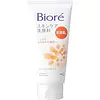What's inside
What's inside
 Key Ingredients
Key Ingredients

 Benefits
Benefits

 Concerns
Concerns

 Ingredients Side-by-side
Ingredients Side-by-side

Water
Skin ConditioningLauryl Glucoside
CleansingSodium Cocoamphoacetate
CleansingGlycerin
HumectantPanthenol
Skin ConditioningDisodium Cocoyl Glutamate
Cleansing1,2-Hexanediol
Skin ConditioningCaprylyl Caprylate
EmollientGuar Hydroxypropyltrimonium Chloride
Skin ConditioningCitric Acid
BufferingSodium Chloride
MaskingNiacinamide
SmoothingXanthan Gum
EmulsifyingArgania Spinosa Kernel Oil
EmollientLysine
Skin ConditioningWater
Skin ConditioningSorbitol
HumectantGlycerin
HumectantMyristic Acid
CleansingLaureth-4 Carboxylic Acid
Lauryl Hydroxysultaine
CleansingPotassium Hydroxide
BufferingLaureth-6 Carboxylic Acid
CleansingLauric Acid
CleansingEthylhexylglycerin
Skin ConditioningAcrylates/C10-30 Alkyl Acrylate Crosspolymer
Emulsion StabilisingPolyquaternium-7
Palmitic Acid
EmollientGlyceryl Stearate
EmollientParfum
MaskingPhenoxyethanol
PreservativePEG-100 Stearate
Disodium EDTA
PEG-6
HumectantPolyquaternium-39
Dipentaerythrityl Tri-Polyhydroxystearate
EmollientSodium Benzoate
MaskingAluminum Hydroxide
EmollientPEG-65m
Emulsion StabilisingBHT
AntioxidantCitronellol
PerfumingGeraniol
PerfumingWater, Sorbitol, Glycerin, Myristic Acid, Laureth-4 Carboxylic Acid, Lauryl Hydroxysultaine, Potassium Hydroxide, Laureth-6 Carboxylic Acid, Lauric Acid, Ethylhexylglycerin, Acrylates/C10-30 Alkyl Acrylate Crosspolymer, Polyquaternium-7, Palmitic Acid, Glyceryl Stearate, Parfum, Phenoxyethanol, PEG-100 Stearate, Disodium EDTA, PEG-6, Polyquaternium-39, Dipentaerythrityl Tri-Polyhydroxystearate, Sodium Benzoate, Aluminum Hydroxide, PEG-65m, BHT, Citronellol, Geraniol
 Reviews
Reviews

Ingredients Explained
These ingredients are found in both products.
Ingredients higher up in an ingredient list are typically present in a larger amount.
Glycerin is already naturally found in your skin. It helps moisturize and protect your skin.
A study from 2016 found glycerin to be more effective as a humectant than AHAs and hyaluronic acid.
As a humectant, it helps the skin stay hydrated by pulling moisture to your skin. The low molecular weight of glycerin allows it to pull moisture into the deeper layers of your skin.
Hydrated skin improves your skin barrier; Your skin barrier helps protect against irritants and bacteria.
Glycerin has also been found to have antimicrobial and antiviral properties. Due to these properties, glycerin is often used in wound and burn treatments.
In cosmetics, glycerin is usually derived from plants such as soybean or palm. However, it can also be sourced from animals, such as tallow or animal fat.
This ingredient is organic, colorless, odorless, and non-toxic.
Glycerin is the name for this ingredient in American English. British English uses Glycerol/Glycerine.
Learn more about GlycerinWater. It's the most common cosmetic ingredient of all. You'll usually see it at the top of ingredient lists, meaning that it makes up the largest part of the product.
So why is it so popular? Water most often acts as a solvent - this means that it helps dissolve other ingredients into the formulation.
You'll also recognize water as that liquid we all need to stay alive. If you see this, drink a glass of water. Stay hydrated!
Learn more about Water